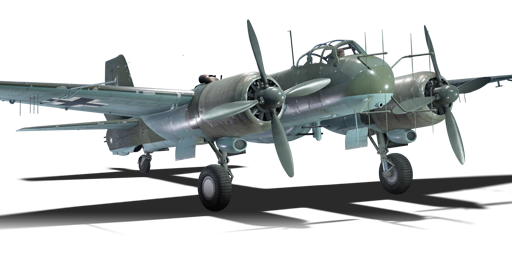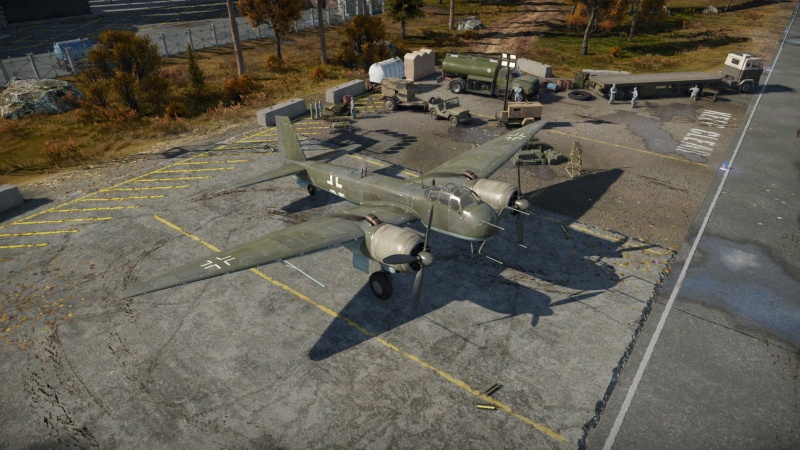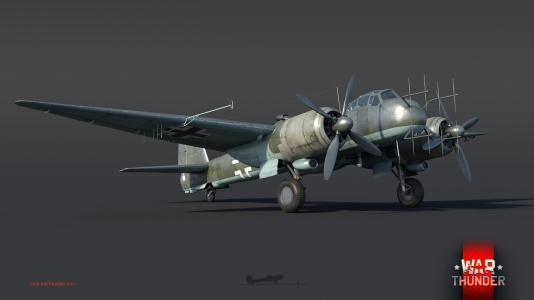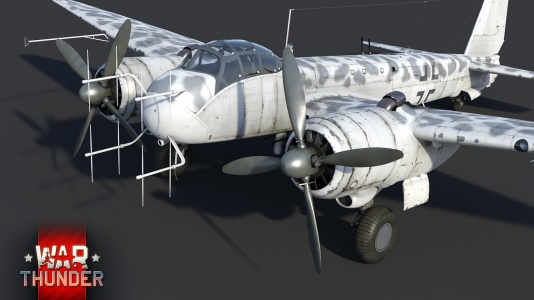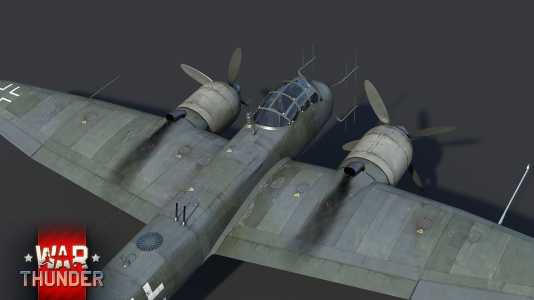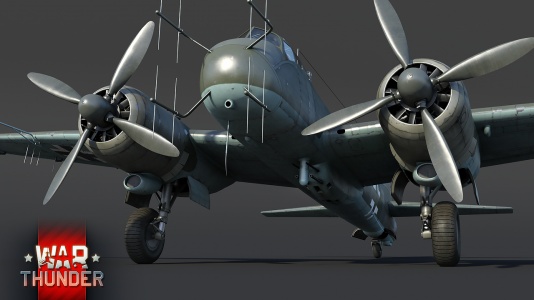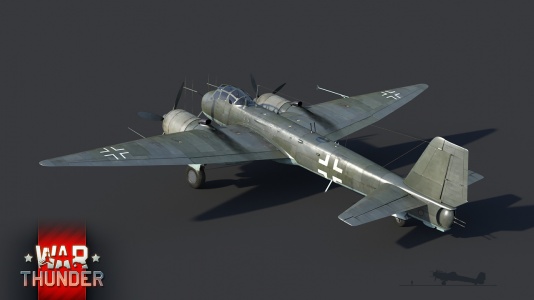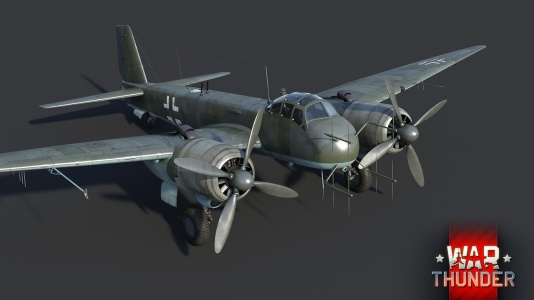Difference between revisions of "Ju 388 J"
(Edits.) |
(Updated description to new format) |
||
| (20 intermediate revisions by 10 users not shown) | |||
| Line 1: | Line 1: | ||
{{Specs-Card | {{Specs-Card | ||
|code=ju-388j | |code=ju-388j | ||
| + | |images={{Specs-Card-Image|GarageImage_{{PAGENAME}}.jpg}} | ||
|market=Ju 388 J (Germany) | |market=Ju 388 J (Germany) | ||
}} | }} | ||
| Line 6: | Line 7: | ||
== Description == | == Description == | ||
<!-- ''In the description, the first part should be about the history of and the creation and combat usage of the aircraft, as well as its key features. In the second part, tell the reader about the aircraft in the game. Insert a screenshot of the vehicle, so that if the novice player does not remember the vehicle by name, he will immediately understand what kind of vehicle the article is talking about.'' --> | <!-- ''In the description, the first part should be about the history of and the creation and combat usage of the aircraft, as well as its key features. In the second part, tell the reader about the aircraft in the game. Insert a screenshot of the vehicle, so that if the novice player does not remember the vehicle by name, he will immediately understand what kind of vehicle the article is talking about.'' --> | ||
| − | [[ | + | As a result of the [[B-29A-BN|B-29]] threat looming over Germany, the RLM (German Ministry of Aviation) set out a requirement for more day fighters that could operate at high altitudes. Many designs were developed and produced, like the Ta 152 H and BV 155. Attempts were made to convert the Ta 154 into a high-altitude fighter but failed due to its wing design. As such, this led to the Ju 88 being repurposed into a bomber destroyer and/or night fighter. Many iterations were developed, like the Ju 188, but the final model would be the Ju 388. The Ju 388 was intended for high-altitude performance. Three variants were planned: the Ju 388 L for photo-reconnaissance, the Ju 388 K for bombing, and the Ju 388 J for fighting enemy aircraft. |
| − | |||
| − | |||
| + | The Ju 388 J was the least produced variant, with only three being built. Germany learned that the B-29s were being deployed to the Pacific, and so production shifted towards the Ju 388 K. Almost all of its defensive armament was removed for weight-shedding and maximum performance. A single remote-controlled turret was mounted in the rear, which provided excellent firing angles. It housed two deadly 13 mm [[MG 131 (13 mm)|MG 131]] machine guns with 600 rounds per gun. It also featured two [[MK 108 (30 mm)|MK 108]]s as well as two [[MG 151 (20 mm)|MG 151]] cannons mounted underneath the fuselage. An additional two MG 151 cannons were installed pointing upwards in a configuration called the Schräge Musik. The Ju 388 J would be powered by the BMW 801TJ engine, a turbocharged radial engine that produced over 1,750 hp. Since the 388 J was also intended for nighttime duties, a VHF band radar was fitted on the nose and had a range of 8 km (4.97 mi). | ||
| + | |||
| + | The '''{{Specs|name}}''' was introduced as a premium reward vehicle for the [[wt:en/news/6145-special-battlefield-engineer-en|"Battlefield Engineer"]] event during [[Update 1.87 "Locked On"]]. For players who do not have it right now, the only way to acquire it is to buy it from the [[War Thunder Market|Marketplace]]. Since the Ju 388 was originally based on the [[Ju 88 (Family)|Ju 88]] bomber, it does not handle well. Even with the improved engines, its overall manoeuvrability is very poor, and the performance is lacklustre. Climbing to high altitudes will be very difficult, and most fights will take place well below the 388 J's optimal combat altitude. The Ju 388 J is a tough plane to use solo, so it is highly advised to stick to teammates or squad up with a friend in a manoeuvrable fighter. | ||
== General info == | == General info == | ||
| − | === Flight | + | === Flight performance === |
| − | ''Describe how the aircraft behaves in the air. Speed, manoeuvrability, acceleration and allowable loads - these are the most important characteristics of the vehicle.'' | + | {{Specs-Avia-Flight}} |
| + | <!-- ''Describe how the aircraft behaves in the air. Speed, manoeuvrability, acceleration and allowable loads - these are the most important characteristics of the vehicle.'' --> | ||
| − | {| class="wikitable" style="text-align:center" | + | {| class="wikitable" style="text-align:center" width="70%" |
| − | + | ! rowspan="2" | Characteristics | |
| − | + | ! colspan="2" | Max Speed<br>(km/h at 10,600 m) | |
| − | + | ! rowspan="2" | Max altitude<br>(metres) | |
| − | ! | ||
| − | |||
| − | ! colspan="2" | Max Speed<br>(km/h at | ||
| − | ! rowspan="2" | Max altitude<br>( | ||
! colspan="2" | Turn time<br>(seconds) | ! colspan="2" | Turn time<br>(seconds) | ||
| − | ! colspan="2" | Rate of climb<br>( | + | ! colspan="2" | Rate of climb<br>(metres/second) |
| − | ! rowspan="2" | Take-off run<br>( | + | ! rowspan="2" | Take-off run<br>(metres) |
|- | |- | ||
| − | ! AB | + | ! AB !! RB !! AB !! RB !! AB !! RB |
| − | ! RB | ||
| − | ! AB | ||
| − | ! RB | ||
| − | ! AB | ||
| − | ! RB | ||
|- | |- | ||
| − | | | + | ! Stock |
| + | | 598 || 581 || rowspan="2" | {{Specs|ceiling}} || 30.4 || 31.6 || 6.6 || 6.5 || rowspan="2" | 1,000 | ||
|- | |- | ||
| − | ! | + | ! Upgraded |
| − | + | | 645 || 621 || 27.7 || 29.0 || 11.7 || 8.9 | |
| − | |||
| − | |||
| − | |||
| − | |||
| − | |||
| − | |||
| − | |||
| − | |||
| − | |||
| − | |||
| − | |||
| − | |||
| − | | | ||
| − | | | ||
|- | |- | ||
|} | |} | ||
==== Details ==== | ==== Details ==== | ||
| − | {| class="wikitable" style="text-align:center" | + | {| class="wikitable" style="text-align:center" width="50%" |
|- | |- | ||
! colspan="5" | Features | ! colspan="5" | Features | ||
|- | |- | ||
| − | ! Combat flaps | + | ! Combat flaps !! Take-off flaps !! Landing flaps !! Air brakes !! Arrestor gear |
| − | ! Take-off flaps | ||
| − | ! Landing flaps | ||
| − | ! Air brakes | ||
| − | ! Arrestor gear | ||
|- | |- | ||
| ✓ || ✓ || ✓ || X || X <!-- ✓ --> | | ✓ || ✓ || ✓ || X || X <!-- ✓ --> | ||
| Line 69: | Line 46: | ||
|} | |} | ||
| − | {| class="wikitable" style="text-align:center" | + | {| class="wikitable" style="text-align:center" width="50%" |
|- | |- | ||
| − | ! colspan=" | + | ! colspan="7" | Limits |
|- | |- | ||
| − | ! rowspan="2" | | + | ! rowspan="2" | Wings (km/h) |
| − | ! rowspan="2" | Gear | + | ! rowspan="2" | Gear (km/h) |
| − | ! | + | ! colspan="3" | Flaps (km/h) |
! colspan="2" | Max Static G | ! colspan="2" | Max Static G | ||
|- | |- | ||
| − | ! + | + | ! Combat !! Take-off !! Landing !! + !! - |
| − | ! - | ||
|- | |- | ||
| − | | {{Specs|destruction| | + | | 675 <!-- {{Specs|destruction|body}} --> || {{Specs|destruction|gear}} || 457 || 428 || 280 || ~11 || ~7 |
|- | |- | ||
|} | |} | ||
| Line 87: | Line 63: | ||
{| class="wikitable" style="text-align:center" | {| class="wikitable" style="text-align:center" | ||
|- | |- | ||
| − | ! colspan="4" | Optimal velocities | + | ! colspan="4" | Optimal velocities (km/h) |
|- | |- | ||
| − | ! Ailerons | + | ! Ailerons !! Rudder !! Elevators !! Radiator |
| − | ! Rudder | ||
| − | ! Elevators | ||
| − | ! Radiator | ||
|- | |- | ||
| < 370 || < 360 || < 400 || > 280 | | < 370 || < 360 || < 400 || > 280 | ||
| − | |||
| − | |||
| − | |||
| − | |||
| − | |||
| − | |||
| − | |||
| − | |||
| − | |||
| − | |||
| − | |||
| − | |||
| − | |||
| − | |||
|- | |- | ||
|} | |} | ||
=== Survivability and armour === | === Survivability and armour === | ||
| + | {{Specs-Avia-Armour}} | ||
''Examine the survivability of the aircraft. Note how vulnerable the structure is and how secure the pilot is, whether the fuel tanks are armoured, etc. Describe the armour, if there is any, and also mention the vulnerability of other critical aircraft systems.'' | ''Examine the survivability of the aircraft. Note how vulnerable the structure is and how secure the pilot is, whether the fuel tanks are armoured, etc. Describe the armour, if there is any, and also mention the vulnerability of other critical aircraft systems.'' | ||
| + | |||
| + | === Modifications and economy === | ||
| + | {{Specs-Economy}} | ||
== Armaments == | == Armaments == | ||
| + | {{Specs-Avia-Armaments}} | ||
=== Offensive armament === | === Offensive armament === | ||
| + | {{Specs-Avia-Offensive}} | ||
<!-- ''Describe the offensive armament of the aircraft, if any. Describe how effective the cannons and machine guns are in a battle, and also what belts or drums are better to use. If there is no offensive weaponry, delete this subsection.'' --> | <!-- ''Describe the offensive armament of the aircraft, if any. Describe how effective the cannons and machine guns are in a battle, and also what belts or drums are better to use. If there is no offensive weaponry, delete this subsection.'' --> | ||
| − | {{main|MK 108 (30 mm)|MG 151 | + | {{main|MK 108 (30 mm)|MG 151 (20 mm)}} |
The '''''{{PAGENAME}}''''' is armed with: | The '''''{{PAGENAME}}''''' is armed with: | ||
* 2 x 30 mm MK 108 cannons, chin-mounted (110 rpg = 220 total) | * 2 x 30 mm MK 108 cannons, chin-mounted (110 rpg = 220 total) | ||
| − | * 2 x 20 mm MG 151 | + | * 2 x 20 mm MG 151 cannons, chin-mounted (180 rpg = 360 total) |
| − | * 2 x 20 mm MG 151 | + | * 2 x 20 mm MG 151 cannons, Schräge Musik mounted mid-fuselage (200 rpg = 400 total) |
=== Defensive armament === | === Defensive armament === | ||
| + | {{Specs-Avia-Defensive}} | ||
<!-- ''Defensive armament with turret machine guns or cannons, crewed by gunners. Examine the number of gunners and what belts or drums are better to use. If defensive weaponry is not available, remove this subsection.'' --> | <!-- ''Defensive armament with turret machine guns or cannons, crewed by gunners. Examine the number of gunners and what belts or drums are better to use. If defensive weaponry is not available, remove this subsection.'' --> | ||
{{main|MG 131 (13 mm)}} | {{main|MG 131 (13 mm)}} | ||
| Line 132: | Line 98: | ||
The '''''{{PAGENAME}}''''' is defended by: | The '''''{{PAGENAME}}''''' is defended by: | ||
| − | * 2 x 13 mm MG 131 machine guns, | + | * 2 x 13 mm MG 131 machine guns, tail turret (600 rpg = 1,200 total) |
== Usage in battles == | == Usage in battles == | ||
| − | ''Describe the tactics of playing in | + | ''Describe the tactics of playing in the aircraft, the features of using aircraft in a team and advice on tactics. Refrain from creating a "guide" - do not impose a single point of view, but instead, give the reader food for thought. Examine the most dangerous enemies and give recommendations on fighting them. If necessary, note the specifics of the game in different modes (AB, RB, SB).'' |
| + | |||
| + | === Radars === | ||
| + | {{main|FuG-202}} | ||
| + | |||
| + | The Ju 388 J is equipped with a FuG-202 search radar, located in the nose of the aircraft; a control box which is part of the radar damage model is located in the rear of the cockpit. | ||
| + | |||
| + | {| class="wikitable" style="text-align:center" | ||
| + | ! colspan="4" | [[FuG-202]] - Target Detection Radar | ||
| + | |- | ||
| + | ! {{Annotation|Maximum<br/>Detection<br/>Range|The maximum possible range at which a target can be detected}} | ||
| + | ! {{Annotation|Guaranteed<br/>Detection<br/>Range|The range, below which, detection of a target is practically guaranteed}} | ||
| + | ! {{Annotation|Max Azimuth<br/>Scan Angle|How far to each side the radar can scan (widest search mode)}} | ||
| + | ! {{Annotation|Max Elevation<br/>Scan Angle|How far up and down the radar can scan (widest search mode)}} | ||
| + | |- | ||
| + | | 4,000 m || 4,000 m || ±30° || ±30° | ||
| + | |- | ||
| + | |} | ||
=== Manual Engine Control === | === Manual Engine Control === | ||
| Line 148: | Line 131: | ||
! rowspan="2" | Turbocharger | ! rowspan="2" | Turbocharger | ||
|- | |- | ||
| − | ! Oil | + | ! Oil !! Water !! Type |
| − | ! Water | ||
| − | ! Type | ||
| − | |||
| − | |||
| − | |||
| − | |||
| − | |||
| − | |||
| − | |||
| − | |||
| − | |||
| − | |||
| − | |||
| − | |||
| − | |||
| − | |||
| − | |||
| − | |||
| − | |||
| − | |||
| − | |||
| − | |||
| − | |||
| − | |||
| − | |||
| − | |||
| − | |||
|- | |- | ||
| − | | | + | | Not controllable || Controllable<br>Auto control available || Controllable<br>Auto control available || Controllable<br>Not auto controlled || Separate || Not controllable<br>1 gear || Not controllable |
| − | | | ||
| − | | | ||
| − | | | ||
| − | | | ||
| − | | | ||
| − | | | ||
| − | | | ||
| − | | | ||
| − | | | ||
| − | | | ||
| − | | | ||
| − | | | ||
|- | |- | ||
|} | |} | ||
=== Pros and cons === | === Pros and cons === | ||
| − | ''Summarise and briefly evaluate the vehicle in terms of its characteristics and combat effectiveness. Mark its pros and cons in the bulleted list. Try not to use more than 6 points for each of the characteristics. Avoid using categorical definitions such as "bad", "good" and the like - use substitutions with softer forms such as "inadequate" and "effective".'' | + | <!-- ''Summarise and briefly evaluate the vehicle in terms of its characteristics and combat effectiveness. Mark its pros and cons in the bulleted list. Try not to use more than 6 points for each of the characteristics. Avoid using categorical definitions such as "bad", "good" and the like - use substitutions with softer forms such as "inadequate" and "effective".'' --> |
'''Pros:''' | '''Pros:''' | ||
| − | * | + | * Good offensive armament of 2 x 30 mm MK 108 and 2 x 20 mm MG 151 cannons |
| + | * Access to the powerful Minengeschoß rounds | ||
| + | * Benefits from an airspawn in RB | ||
| + | * Excellent bomber hunter | ||
| + | * Schräge Musik 20 mm cannons with dedicated gunsight | ||
'''Cons:''' | '''Cons:''' | ||
| − | * | + | * Subpar roll rate, speed and overall performance |
| + | * Hard to get guns on target | ||
| + | * Bad climb rate | ||
| + | * Can't sustain any turnfight | ||
== History == | == History == | ||
| − | <!-- ''Describe the history of the creation and combat usage of the aircraft in more detail than in the introduction. If the historical reference turns out to be too long, take it to a separate article, taking a link to the article about the vehicle and adding a block "/ History" (example: <nowiki>https://wiki.warthunder.com/(Vehicle-name)/History</nowiki>) and add a link to it here using the <code>main</code> template. Be sure to reference text and sources by using <code><nowiki><ref></ref></nowiki></code>, as well as adding them at the end of the article with <code><nowiki><references /></nowiki></code>. This section may also include the vehicle's dev blog entry (if applicable) and the in-game encyclopedia description (under <code><nowiki>=== | + | <!-- ''Describe the history of the creation and combat usage of the aircraft in more detail than in the introduction. If the historical reference turns out to be too long, take it to a separate article, taking a link to the article about the vehicle and adding a block "/History" (example: <nowiki>https://wiki.warthunder.com/(Vehicle-name)/History</nowiki>) and add a link to it here using the <code>main</code> template. Be sure to reference text and sources by using <code><nowiki><ref></ref></nowiki></code>, as well as adding them at the end of the article with <code><nowiki><references /></nowiki></code>. This section may also include the vehicle's dev blog entry (if applicable) and the in-game encyclopedia description (under <code><nowiki>=== In-game description ===</nowiki></code>, also if applicable).'' --> |
| − | After the German Ministry of Aviation (RLM) found out about the new American B-29 Superfortress in 1942, serious concerns were raised among high ranking officials, questioning the | + | The Ju 388 J is the heavy-fighter version of the Ju 388, a multirole twin-engined combat aircraft built by Germany late into the Second World War. Based on the Ju 188 and Ju 88, the aircraft was optimized for high-altitude operations to counter the formidable B-29 Superfortress; the aircraft incorporated specific design features for this role including a pressurized cockpit. However, the aircraft was plagued by technical issues and entered service late into the war, meaning that it saw little service. |
| + | |||
| + | In late 1942, the German Air Ministry (or RLM) first learned of the American B-29 Superfortress, which would've been capable of cruising such a high altitude (8000-10000 metres) that no German aircraft could counter it effectively. As a result, the RLM authorized the development of several new aircraft to counter the Superfortress, including the Ta 152 H. For the bomber destroyer role, several aircraft were considered including the Do 335, Ta 152 and He 219: the He 219 and Ta 152 weren't optimized for high-altitude flight and were subsequently not considered, while the Do 335 was still in a prototype stage with production models not expected until 1944. | ||
| + | |||
| + | As a result, the RLM authorized the development of the Ju 388, based on the airframe of the Ju 188 fast-bomber, which was in turn based on the Ju 88. Compared to the Ju 188, the Ju 388 featured numerous changes, including the removal of most defensive armament; instead, a pair of 13 mm machine guns were mounted in the tail, remotely controlled from the crew cabin. The Ju 388 K and L (the bomber and reconnaissance versions) retained the glazed nose of the Ju 188, while the Ju 388 J featured a solid nose housing two 20 mm MG 151/20 and two 30 mm MK 108 cannons. | ||
| + | |||
| + | The Ju 388 first entered service in 1944; roughly 100 Ju 388 aircraft of all models were built in total (the exact number is not known). However, only three Ju 388 J aircraft were completed. The aircraft were used against allied bombers in WW2, and were also proposed for export to Japan. Following the end of the war, a single Ju 388 L was acquired by the USAF for testing purposes - this aircraft is now stored at the Smithsonian National Air and Space Museum in Washington DC, and is the only Ju 388 still intact today. | ||
| + | |||
| + | === [[wt:en/news/6138-development-junkers-ju-388-j-the-high-altitude-marauder-en|Devblog]] === | ||
| + | After the German Ministry of Aviation (RLM) found out about the new American B-29 Superfortress in 1942, serious concerns were raised among high ranking officials, questioning the Luftwaffe's ability to deal with such a new potential threat. At the time, the B-29 flew higher and faster than any fighter the Luftwaffe had at their disposal and the only weapon that could effectively counter it was the 12.8cm FlaK 40 heavy AA cannon. This led to the development of a range of new German high-altitude fighters, interceptors and dedicated bomber hunters. | ||
The first prototype of the Ju 388 performed its maiden flight in December 1943, showing promising results. After the construction and testing of six further prototypes were completed in three modifications: the Ju 388J high-altitude interceptor, a Ju 388K medium bomber and the Ju 388L scout. The Ju 388 was ordered into production and was officially introduced into Luftwaffe service in summer 1944. However, initial production progressed at a slow pace due to the limited availability of the required engines for the aircraft. Furthermore, the continuously worsening war conditions in Germany had a severe impact on overall production, eventually preventing it entirely by the end of the war. | The first prototype of the Ju 388 performed its maiden flight in December 1943, showing promising results. After the construction and testing of six further prototypes were completed in three modifications: the Ju 388J high-altitude interceptor, a Ju 388K medium bomber and the Ju 388L scout. The Ju 388 was ordered into production and was officially introduced into Luftwaffe service in summer 1944. However, initial production progressed at a slow pace due to the limited availability of the required engines for the aircraft. Furthermore, the continuously worsening war conditions in Germany had a severe impact on overall production, eventually preventing it entirely by the end of the war. | ||
In the end, only around 100 Ju 388s were built with most aircraft seeing only limited action during their short service life during the final stages of WW2. | In the end, only around 100 Ju 388s were built with most aircraft seeing only limited action during their short service life during the final stages of WW2. | ||
| − | |||
| − | |||
== Media == | == Media == | ||
<!-- ''Excellent additions to the article would be video guides, screenshots from the game, and photos.'' --> | <!-- ''Excellent additions to the article would be video guides, screenshots from the game, and photos.'' --> | ||
| + | |||
| + | ;Skins | ||
| + | |||
| + | * [https://live.warthunder.com/feed/camouflages/?vehicle=ju-388j Skins and camouflages for the {{PAGENAME}} from live.warthunder.com.] | ||
| + | |||
;Images | ;Images | ||
| − | < | + | <gallery mode="packed" heights="200"> |
| − | + | File:Ju 388J WTWallpaper 001.jpg | |
| − | + | File:Ju 388J WTWallpaper 002.jpg | |
| − | + | File:Ju 388J WTWallpaper 003.jpg | |
| − | + | File:Ju 388J WTWallpaper 004.jpg | |
| − | + | File:Ju 388J WTWallpaper 005.jpg | |
| − | + | File:Ju 388J WTWallpaper 007.jpg | |
| − | + | </gallery> | |
| + | |||
| + | ;Videos | ||
| + | {{Youtube-gallery|gFJBLbLH6dY|'''Massive Off-centered FirePower! {{PAGENAME}} Review''' - ''Jengar''|yWWFv8qY5rQ|'''Battlefield Engineer: all new vehicles''' discusses the {{PAGENAME}} at 6:44 - ''War Thunder Official Channel''}} | ||
== See also == | == See also == | ||
| Line 235: | Line 201: | ||
<!-- ''Paste links to sources and external resources, such as:'' | <!-- ''Paste links to sources and external resources, such as:'' | ||
* ''topic on the official game forum;'' | * ''topic on the official game forum;'' | ||
| − | |||
* ''other literature.'' --> | * ''other literature.'' --> | ||
| − | * [ | + | * [[wt:en/news/6138-development-junkers-ju-388-j-the-high-altitude-marauder-en|[Development] Junkers Ju 388 J: The High-Altitude Marauder]] |
| + | * [https://forum.warthunder.com/index.php?/topic/453804-ju-388j-0/ Official data sheet - more details about the performance] | ||
| + | {{AirManufacturer Junkers}} | ||
{{Germany twin-engine fighters}} | {{Germany twin-engine fighters}} | ||
{{Germany premium aircraft}} | {{Germany premium aircraft}} | ||
Latest revision as of 21:25, 21 October 2023
Contents
Description
As a result of the B-29 threat looming over Germany, the RLM (German Ministry of Aviation) set out a requirement for more day fighters that could operate at high altitudes. Many designs were developed and produced, like the Ta 152 H and BV 155. Attempts were made to convert the Ta 154 into a high-altitude fighter but failed due to its wing design. As such, this led to the Ju 88 being repurposed into a bomber destroyer and/or night fighter. Many iterations were developed, like the Ju 188, but the final model would be the Ju 388. The Ju 388 was intended for high-altitude performance. Three variants were planned: the Ju 388 L for photo-reconnaissance, the Ju 388 K for bombing, and the Ju 388 J for fighting enemy aircraft.
The Ju 388 J was the least produced variant, with only three being built. Germany learned that the B-29s were being deployed to the Pacific, and so production shifted towards the Ju 388 K. Almost all of its defensive armament was removed for weight-shedding and maximum performance. A single remote-controlled turret was mounted in the rear, which provided excellent firing angles. It housed two deadly 13 mm MG 131 machine guns with 600 rounds per gun. It also featured two MK 108s as well as two MG 151 cannons mounted underneath the fuselage. An additional two MG 151 cannons were installed pointing upwards in a configuration called the Schräge Musik. The Ju 388 J would be powered by the BMW 801TJ engine, a turbocharged radial engine that produced over 1,750 hp. Since the 388 J was also intended for nighttime duties, a VHF band radar was fitted on the nose and had a range of 8 km (4.97 mi).
The Ju 388 J was introduced as a premium reward vehicle for the "Battlefield Engineer" event during Update 1.87 "Locked On". For players who do not have it right now, the only way to acquire it is to buy it from the Marketplace. Since the Ju 388 was originally based on the Ju 88 bomber, it does not handle well. Even with the improved engines, its overall manoeuvrability is very poor, and the performance is lacklustre. Climbing to high altitudes will be very difficult, and most fights will take place well below the 388 J's optimal combat altitude. The Ju 388 J is a tough plane to use solo, so it is highly advised to stick to teammates or squad up with a friend in a manoeuvrable fighter.
General info
Flight performance
| Characteristics | Max Speed (km/h at 10,600 m) |
Max altitude (metres) |
Turn time (seconds) |
Rate of climb (metres/second) |
Take-off run (metres) | |||
|---|---|---|---|---|---|---|---|---|
| AB | RB | AB | RB | AB | RB | |||
| Stock | 598 | 581 | 13000 | 30.4 | 31.6 | 6.6 | 6.5 | 1,000 |
| Upgraded | 645 | 621 | 27.7 | 29.0 | 11.7 | 8.9 | ||
Details
| Features | ||||
|---|---|---|---|---|
| Combat flaps | Take-off flaps | Landing flaps | Air brakes | Arrestor gear |
| ✓ | ✓ | ✓ | X | X |
| Limits | ||||||
|---|---|---|---|---|---|---|
| Wings (km/h) | Gear (km/h) | Flaps (km/h) | Max Static G | |||
| Combat | Take-off | Landing | + | - | ||
| 675 | 310 | 457 | 428 | 280 | ~11 | ~7 |
| Optimal velocities (km/h) | |||
|---|---|---|---|
| Ailerons | Rudder | Elevators | Radiator |
| < 370 | < 360 | < 400 | > 280 |
Survivability and armour
Examine the survivability of the aircraft. Note how vulnerable the structure is and how secure the pilot is, whether the fuel tanks are armoured, etc. Describe the armour, if there is any, and also mention the vulnerability of other critical aircraft systems.
Modifications and economy
Armaments
Offensive armament
The Ju 388 J is armed with:
- 2 x 30 mm MK 108 cannons, chin-mounted (110 rpg = 220 total)
- 2 x 20 mm MG 151 cannons, chin-mounted (180 rpg = 360 total)
- 2 x 20 mm MG 151 cannons, Schräge Musik mounted mid-fuselage (200 rpg = 400 total)
Defensive armament
The Ju 388 J is defended by:
- 2 x 13 mm MG 131 machine guns, tail turret (600 rpg = 1,200 total)
Usage in battles
Describe the tactics of playing in the aircraft, the features of using aircraft in a team and advice on tactics. Refrain from creating a "guide" - do not impose a single point of view, but instead, give the reader food for thought. Examine the most dangerous enemies and give recommendations on fighting them. If necessary, note the specifics of the game in different modes (AB, RB, SB).
Radars
The Ju 388 J is equipped with a FuG-202 search radar, located in the nose of the aircraft; a control box which is part of the radar damage model is located in the rear of the cockpit.
| FuG-202 - Target Detection Radar | |||
|---|---|---|---|
| Maximum Detection Range |
Guaranteed Detection Range |
Max Azimuth Scan Angle |
Max Elevation Scan Angle |
| 4,000 m | 4,000 m | ±30° | ±30° |
Manual Engine Control
| MEC elements | ||||||
|---|---|---|---|---|---|---|
| Mixer | Pitch | Radiator | Supercharger | Turbocharger | ||
| Oil | Water | Type | ||||
| Not controllable | Controllable Auto control available |
Controllable Auto control available |
Controllable Not auto controlled |
Separate | Not controllable 1 gear |
Not controllable |
Pros and cons
Pros:
- Good offensive armament of 2 x 30 mm MK 108 and 2 x 20 mm MG 151 cannons
- Access to the powerful Minengeschoß rounds
- Benefits from an airspawn in RB
- Excellent bomber hunter
- Schräge Musik 20 mm cannons with dedicated gunsight
Cons:
- Subpar roll rate, speed and overall performance
- Hard to get guns on target
- Bad climb rate
- Can't sustain any turnfight
History
The Ju 388 J is the heavy-fighter version of the Ju 388, a multirole twin-engined combat aircraft built by Germany late into the Second World War. Based on the Ju 188 and Ju 88, the aircraft was optimized for high-altitude operations to counter the formidable B-29 Superfortress; the aircraft incorporated specific design features for this role including a pressurized cockpit. However, the aircraft was plagued by technical issues and entered service late into the war, meaning that it saw little service.
In late 1942, the German Air Ministry (or RLM) first learned of the American B-29 Superfortress, which would've been capable of cruising such a high altitude (8000-10000 metres) that no German aircraft could counter it effectively. As a result, the RLM authorized the development of several new aircraft to counter the Superfortress, including the Ta 152 H. For the bomber destroyer role, several aircraft were considered including the Do 335, Ta 152 and He 219: the He 219 and Ta 152 weren't optimized for high-altitude flight and were subsequently not considered, while the Do 335 was still in a prototype stage with production models not expected until 1944.
As a result, the RLM authorized the development of the Ju 388, based on the airframe of the Ju 188 fast-bomber, which was in turn based on the Ju 88. Compared to the Ju 188, the Ju 388 featured numerous changes, including the removal of most defensive armament; instead, a pair of 13 mm machine guns were mounted in the tail, remotely controlled from the crew cabin. The Ju 388 K and L (the bomber and reconnaissance versions) retained the glazed nose of the Ju 188, while the Ju 388 J featured a solid nose housing two 20 mm MG 151/20 and two 30 mm MK 108 cannons.
The Ju 388 first entered service in 1944; roughly 100 Ju 388 aircraft of all models were built in total (the exact number is not known). However, only three Ju 388 J aircraft were completed. The aircraft were used against allied bombers in WW2, and were also proposed for export to Japan. Following the end of the war, a single Ju 388 L was acquired by the USAF for testing purposes - this aircraft is now stored at the Smithsonian National Air and Space Museum in Washington DC, and is the only Ju 388 still intact today.
Devblog
After the German Ministry of Aviation (RLM) found out about the new American B-29 Superfortress in 1942, serious concerns were raised among high ranking officials, questioning the Luftwaffe's ability to deal with such a new potential threat. At the time, the B-29 flew higher and faster than any fighter the Luftwaffe had at their disposal and the only weapon that could effectively counter it was the 12.8cm FlaK 40 heavy AA cannon. This led to the development of a range of new German high-altitude fighters, interceptors and dedicated bomber hunters.
The first prototype of the Ju 388 performed its maiden flight in December 1943, showing promising results. After the construction and testing of six further prototypes were completed in three modifications: the Ju 388J high-altitude interceptor, a Ju 388K medium bomber and the Ju 388L scout. The Ju 388 was ordered into production and was officially introduced into Luftwaffe service in summer 1944. However, initial production progressed at a slow pace due to the limited availability of the required engines for the aircraft. Furthermore, the continuously worsening war conditions in Germany had a severe impact on overall production, eventually preventing it entirely by the end of the war.
In the end, only around 100 Ju 388s were built with most aircraft seeing only limited action during their short service life during the final stages of WW2.
Media
- Skins
- Images
- Videos
See also
Links to the articles on the War Thunder Wiki that you think will be useful for the reader, for example:
- reference to the series of the aircraft;
- links to approximate analogues of other nations and research trees.
External links
- [Development] Junkers Ju 388 J: The High-Altitude Marauder
- Official data sheet - more details about the performance
| Junkers Aircraft and Motor Works (Junkers Flugzeug- und Motorenwerke Aktiengesellschaft) | |
|---|---|
| Fighters | Ju 88 C-6 · Ju 388 J |
| Strike Aircraft | |
| Ju 87 | Ju 87 G-1 · Ju 87 G-2 |
| Bombers | Ju 88 A-1 · Ju 88 A-4 · Ju 188 A-2 · Ju 288 C |
| Ju 87 | Ju 87 B-2 · Ju 87 D-3 · Ju 87 D-5 · Ju 87 R-2 · Ju 87 R-2 Libya |
| Export | ▄Ju 87 D-3 · ▄Ju 87 R-2 · ▄Ju 88 A-4 |
| Germany twin-engine fighters | |
|---|---|
| Messerschmitt | Bf 109 Z-1 |
| Me 410 A-1/U2 · Me 410 B-1/U2 | |
| Dornier | Do 17 Z-7 · Do 217 J-1 · Do 217 J-2 · Do 217 N-1 · Do 217 N-2 |
| Focke-Wulf | Ta 154 A-1 |
| Junkers | Ju 88 C-6 · Ju 388 J |
| Germany premium aircraft | |
|---|---|
| Fighters | He 51 B-2/H · BV 155 B-1 |
| He 112 | He 112 B-1/U2 · He 112 B-2/U2 |
| Bf 109 | Flegel's Bf 109 A · Bf 109 E-7/U2 · Bf 109 G-2 |
| Fw 190 | Fw 190 A-5/U14 · Fw 190 C · Fw 190 D-13 |
| Captured | ▀Marcolin's C.R.42 CN · ▀Hawk H-75A-2 · ▀Yak-1B · ▀La-5FN · ▀P-47D-16-RE · ▀P-47D · ▀Tempest Mk V |
| Twin-engine fighters | Bf 109 Z-1 · Ju 388 J · Ta 154 A-1 |
| Jet fighters | ◄Sea Hawk Mk.100 · ◄G.91 R/4 · FFA P-16 · ◄MiG-21 SPS-K · ◊MiG-21 "Lazur-M" |
| Strike aircraft | Hs 129 B-2 (Romania) · ▀IL-2 (1942) · Bf 110 C-6 · Do 335 B-2 · He 219 A-7 · ◄Tornado IDS WTD61 · ◄Su-22M4 WTD61 |
| Bombers | Ar 196 A-3 · BV 238 · Fw 189 A-1 · He 177 A-3 · Ju 87 R-2 Libya · Ju 288 C · ▀Wellington Mk Ic |


